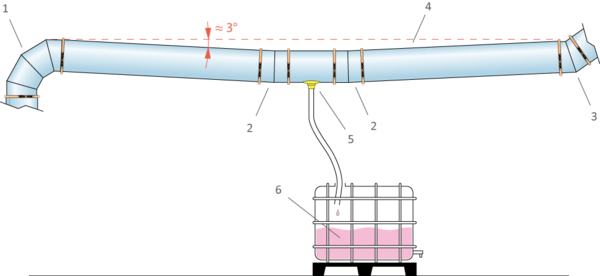Kitchen Ventilation

Air-ducts for Commercial Kitchens - Purpose
Removal of water vapor, oil, grease, dirt, condensates, odors and other substances that arise during cooking. Kitchen ventilation ducts are probably among those which are the most difficult to clean (and to maintain clean to avoid fires).
Air-duct Requirements
The air ducts should be aerosol-tight.
The surfaces of the air ducts (the inside but also to a certain degree the outside ones) should be smooth and easy to clean and disinfect. In this respect, stainless steel ducts are more appropriate than galvanized steel ones.
Since the detergents required for the cleaning of the ductwork are often liquids or in the form of foams, the air-ducts, fittings and connections should not only be air but also liquid-tight.
The duct sections should be slightly inclined in order to direct the liquids towards the drain-fittings by gravity.
The gaskets should be resistant to the cleaning agents commonly used for the cleaning of air-ducts. According to the cleaning company IMMLER the NBR gasket is resistant to the common detergents used for the cleaning of air ducts (see test report; only in German)
Access doors should be installed every time the ventilation ducts change directions (bends), as well as in front and behind butterfly valves and dampers.
The access doors, like the air-ducts, should be aerosol-tight and oil-tight.
The METU Solutions
METU-FORM system of round ducts, fittings and connections
Laser welded smooth straight round ducts (from 71 to 1000 mm Ø)
Laser or MIG-welded fittings (from 71 to 1000 mm Ø)
Smooth surfaces (VDI 18869 Part 4)
Available in galvanized or stainless steel 1.4301 / V2A (ZI-101)
Air-tightness above the highest class D according to the norm DIN EN 12237
Oil and aerosol tightness class ATC 1 according to the norm DIN EN 16798-3
Liquid-tight connections with integrated NBR seal (VDI 2052)
Liquid-tight access doors RD and RRD with NBR gasket.
Access doors with silicon gasket (SI) resitsing temperatres up to 200°C.
Air-duct washing out operations
Drain fittings for rectangular and round ducts (ST-G and ST-K)
Drain fittings the oil-gutters on kitchen hoods (ST-K)

Ductwork cleaning companies can work with liquid detergents without worrying about leaks. The smooth inner surfaces (VDI 18869 Part 4) of the METU-FORM ducts allow an efficient cleaning. Cost and time are saved.
1. Kitchen hood
2. Liquid detergents
3. Laser-welded straight ducts
4. Laser-welded and MIG-welded fittings
5. Oil-tight SRX Joining Clips with NBR gasket
6. Access doors for commercial kitchens
7. ST-K Drain Fittings
Access Doors for Commercial Kitchens
We recommend to use the liquid-tight access doors (RD with NBR gasket and RRD with NBR gasket), tightness class ATC1 according to the EN 16798-3). The NBR seal is largely resistant to oils and greases. In view of the sometimes complicated conditions in kitchens, minor leaks cannot be completely ruled out. The suggested solution is nevertheless the most suitable one from our product range.
Finally, we could install standard access doors with polyethylene (PE) gasket. The PE gasket is only partially resistant to organic oils and greases (see ZI-201). Also, it will soon be soaked with oil and grease and start leaking.

1. 90° Elbow minus about 3°
2. Spacial 3° degrees ebow
3. Elbow with a non-standard angle
4. Slope
5. Drain fitting ST-K
6. Oils (process industry), condensation, liquid detergents (Kitchens), etc.
Remarks
The use of ozone and other photochemical processes (UV-light) can lead to accelerated oxidation of steel (galv. and stainless steels), gaskets and other air-duct components.
A Few Norms and Guidelines
VDI-Guideline 6022
Hygiene Requirements for Ventilation and Air-conditioning Systems
VDI- Guideline 2052
Ventilation Equipment for Kitchens
DIN EN 16282
Equipment for Commercial Kitchens - Ventilation Components in Commercial Kitchens
DIN EN 12237
Strength and leakage of circular sheet metal ducts
DIN EN 16798-3
Performance requirements for Ventilation and Room-conditioning Systems
Guideline M-LüAR
Fire-protection Directive for Ventilation Systems



